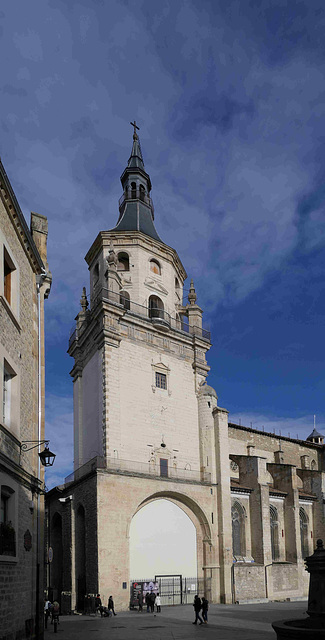Vitoria-Gasteiz - Catedral de Santa María
Vitoria-Gasteiz - Catedral de Santa María
Vitoria-Gasteiz - Catedral de Santa María
Vitoria-Gasteiz - Catedral de Santa María
Vitoria-Gasteiz
Vitoria-Gasteiz - Catedral de Santa María
Vitoria-Gasteiz - Basílica de San Prudencio
Vitoria-Gasteiz - Basílica de San Prudencio
Vitoria-Gasteiz - Basílica de San Prudencio
Vitoria-Gasteiz - Basílica de San Prudencio
Vitoria-Gasteiz - Basílica de San Prudencio
Vitoria-Gasteiz - Basílica de San Prudencio (PiP)
Vitoria-Gasteiz - Basílica de San Prudencio
Vitoria-Gasteiz - Basílica de San Prudencio
Vitoria-Gasteiz - Basílica de San Prudencio
Vitoria-Gasteiz - Basílica de San Prudencio
Vitoria-Gasteiz - Basílica de San Prudencio
Haro
Haro - Calzados Prieto
Logroño - San Bartolomé
Logroño - San Bartolomé
Logroño - Street Art
Soria
Vitoria-Gasteiz - Oficina de Correos
Vitoria-Gasteiz - Plaza de la Virgen Blanca
Bidart - Erretegia Beach
Saint-Justin - Chambre d'arrêt
Penne-d’Agenais - Sanctuaire Notre-Dame de Peyragu…
Penne-d’Agenais - Sanctuaire Notre-Dame de Peyragu…
Arcambal - Le Lot (PiP)
Saint-Martin-de-Vers - Saint-Martin-de-Vers
Souillac - Sainte-Marie
Bourges - Cathedral
Bourges - Nouvelles Galeries
Bourges - Etablissements Aubrun
Bourges - Place Planchat
Bourges - Place Gourdaine
Bourges - Halle Saint-Bonnet
La Charité-sur-Loire - Notre-Dame
La Charité-sur-Loire - Notre-Dame
La Charité-sur-Loire - Notre-Dame
La Charité-sur-Loire - Notre-Dame
La Charité-sur-Loire - Notre-Dame
Auxerre - Di Napoli
Auxerre - Tour de l’Horloge
Location
See also...
Keywords
Authorizations, license
-
Visible by: Everyone -
All rights reserved
-
12 visits
Vitoria-Gasteiz - Catedral de Santa María


The Visigoth king Leovigild founded a city called Victoriacum on the occasion of a victory over the Basques in the 6th century. In 1181, King Sancho the Wise of Navarre founded what is now Vitoria, named Nueva Victoria. This was an extension of the already existing Basque settlement of Gasteiz, which was developed into a fortification against Castile. In 1199, the town was besieged for nine months and eventually captured by the troops of Alfonso VIII of Castile, who annexed the town to the Kingdom of Castile. The town was progressively enlarged and in 1431 it was granted a city charter.
The Battle of Vitoria of the Peninsular War occurred near Vitoria-Gasteiz on 21 June 1813. An allied army under General Wellington broke the French army under Joseph Bonaparte. The victory assured the eventual end of French control in Spain. There is a monument commemorating this battle in the main square of the city known as the Monument to Independence.
Construction of the Cathedral of Santa María in Gothic style began in the late 13th century and continued throughout the 14th century. It was conceived as a fortress church, with great volume and enclosed appearance, being part of the city's defenses. From 1496 to 1861 it served as a collegiate church. In 1862 the church became the cathedral of the newly created Diocese of Vitoria until the new María Inmaculada Cathedral was completed in 1914.
It has a Latin-cross plan, with a wide transept crossing and circular apse containing several chapels.
The Battle of Vitoria of the Peninsular War occurred near Vitoria-Gasteiz on 21 June 1813. An allied army under General Wellington broke the French army under Joseph Bonaparte. The victory assured the eventual end of French control in Spain. There is a monument commemorating this battle in the main square of the city known as the Monument to Independence.
Construction of the Cathedral of Santa María in Gothic style began in the late 13th century and continued throughout the 14th century. It was conceived as a fortress church, with great volume and enclosed appearance, being part of the city's defenses. From 1496 to 1861 it served as a collegiate church. In 1862 the church became the cathedral of the newly created Diocese of Vitoria until the new María Inmaculada Cathedral was completed in 1914.
It has a Latin-cross plan, with a wide transept crossing and circular apse containing several chapels.
Alexander Prolygin has particularly liked this photo
- Keyboard shortcuts:
Jump to top
RSS feed- Latest comments - Subscribe to the comment feeds of this photo
- ipernity © 2007-2024
- Help & Contact
|
Club news
|
About ipernity
|
History |
ipernity Club & Prices |
Guide of good conduct
Donate | Group guidelines | Privacy policy | Terms of use | Statutes | In memoria -
Facebook
Twitter

Sign-in to write a comment.